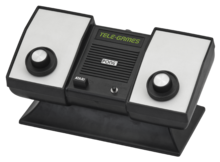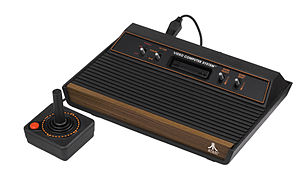Pong and the others: Atari, where everything started
In 1971, Nolan Bushnell and Ted Dabney founded a small engineering company, Syzygy Engineering, that designed and built Computer Space, the world's first commercially available arcade video game, for Nutting Associates. On June 27, 1972, the two incorporated Atari, Inc. and soon hired Al Alcorn as their first design engineer.
Computer Space was the first "coin-op" game, and was realized without even a microprocessor!
The entire computer system is a state machine made of 74-series TTL chips. Graphic elements are held in diode arrays.1
The cabinet of Computer Space:

Atari was a "startup" of the '70, and even Steve Jobs and Wozniak worked here (Bushnell could have been an Apple cofounder himself, but turned down the opportunity).2
Atari history wrap-up
Atari had many souls: we can split its history into three parts.
The first company lived from 1972 to 1984. After the video game crash of 1983, Jack Tramiel purchased Atari from Warner, but Warner retained the "Atari Games" division sold to Namco.
Tramiel developed the Atari ST. Then in the 1996 the failure of the Atari Lynx handheld console and the Jaguar 64bit console brought Atari out of business and was eventually acquired by JTS Corporation for a short period and then by Hasbro
In 2000 the French software publisher Infogrames created Atari SA company, coming back to releasing games like Never Winter Nights (RPG) and V-Rally. Sometimes you see the Atari logo in the games released for Xbox and PlayStation: now Atari is an intellectual property holder, and no more hardware is produced.
Atari tried to capitalize its history announcing in 2017 the Atari VCS, hardware but the launch was delayed up to the end of 2019, and we are still waiting.... By the way, it is rather difficult to enter in the console videogames nowadays.
The Pong Console
Atari produced Pong as a coin-op game, then Atari decided to produce an home version.
Pong is a table tennis sports game featuring simple two-dimensional graphics.

Pong was the first commercially successful video game, which helped to establish the video game industry along with the first home console, the Magnavox Odyssey. The company released several sequels which built upon the original's gameplay by adding new features.
Pong was the first game developed by Atari.
After producing Computer Space, Bushnell decided to form a company to produce more games by licensing ideas to other companies.
Allan Alcorn created Pong as a training exercise assigned to him by Atari co-founder Nolan Bushnell. Prior to working at Atari, Allan Alcorn had no experience with video games.
To acclimate Alcorn to creating games, Bushnell gave him a project secretly meant to be a warm-up exercise.
The company announced Pong on 29 November 1972.
When the company did file for patents, complications delayed the process.
The Atari 2600 (1977)

Atari 2600 / Atari VCS
The Atari 2600, originally sold as the Atari Video Computer System (VCS) is a home video game console from Atari, Inc. Released on September 11, 1977, it is credited with popularizing the use of microprocessor-based hardware and games contained on ROM cartridges, a format first used with the Fairchild Channel F in 1976.
Atari 2600 Highlights
Ultimately, the consoles were shipped to retailers in November 1977.
Atari sold between 350,000 and 400,000 Atari VCS units during 1977.
Atari 2600 Hardware
Atari 2600 deserve a detailed hardware description because it was the first home computer console sold in huge quantities. Also, it is the only console which survived to the video game crash of 1983, because it was very cheap to produce and keep going up to 1992!
The Atari 2600's CPU is the MOS Technology 6507, stripped down version of the 6502 running at 1.19 MHz with only 13 memory-address instead of 16, so it was cheaper to produce.
The 6502 will be the dominant chip of the 8-bit computers of the '80. For instance, Microsoft Basic will be developed for this chip and sold to various company. So it is not a surprise the 6502 and variant are shared by Atari, Commodore and NES, even with variants.
You can think the 6502 is like JavaScript in 2022 (or Java in the 2000): a "lingua franca" most programmers knows, and able to offer a good job.
The designers of the Atari 2600 selected an inexpensive cartridge interface that had one fewer address than the 13 allowed by the 6507, further reducing the already limited addressable memory to 4 Kb (2^12 = 4096).
Initially, each VCS game fit into a 2K ROM so having double the address space seems okey.
Later games get around this limitation with bank switching, up to the 32Kb limit.
So the memory map was:
| Address range | Size | Description |
|---|---|---|
| $0000-$007F | $80 | TIA Registers (128 bytes) |
| $0080-$00FF | $80 | PIA RAM (128 bytes of scratch space) |
| $0100-$01FF | $FF | Stack space. Reamps PIA RAM at $180-$1FF |
| $0280-$0297 | $18 | I/O Like Joystick, Console switches and timers |
| $0298-$EFFF | Unaddressable space | |
| $F000-$FFFF | $1000 | 4Kb Cartridge address space |
The console has only 128 bytes of RAM for scratch space, the call stack, and the state of the game world.
For comparison, a PS4 has about 8*10^9 bytes of RAM!
Programming was hard because:
- The graphic chip (TIA) was able to buffer only one line at a time. So you end up creating the image line by line, with the 6502 busy on rendering every line!
- You must do all the game logic between the end of one frame and the start of the next one (i.e. score updates and so on)
- You have no tiles or character map
- You have two "sprites" which are 8 bit wide and 1 bit high and cannot be easily positioned in X,Y coordinates.
Intellivision 1979
Intellivision
The Intellivision is a home video game console released by Mattel Electronics in 1979. The name Intellivision is a portmanteau of "intelligent television".
Intellivision Highlights
The name Intellivision is a portmanteau of "intelligent television"
In 2009, video game website IGN named the Intellivision the No
Mattel identified a new but expensive chipset from National Semiconductor and negotiated better pricing for a simpler design
Mattel Electronics would become a subsidiary in 1981
Before Mattel shifted manufacturing to Hong Kong, Mattel Intellivisions were manufactured by GTE Sylvania
Mattel formed its own software development group and began hiring programmers
In public, the programmers were referred to collectively as the Blue Sky Rangers
Mattel organized its games into networks: Major League Sports, Action, Strategy, Gaming, Children's Learning and later Space Action, and Arcade
Mattel Electronics' team of programmers was diverse in experience and talent, proving to be an advantage
Shark!
Two tracks are read only for the software, and two tracks for user data
It uses the Intellivision's power supply
In the fall of 1981 design changes were finally implemented and the Keyboard Component was released at $600 in Seattle and New Orleans only
Mattel provided a full refund but without a receipt paid $550 for the Keyboard Component, $60 for the BASIC cartridge, and $30 for each cassette software
Today, very few of them still exist
Many of the units were dismantled for parts
In the fall of 1982, the LUCKI, now renamed the Entertainment Computer System (ECS), was presented at the annual sales meeting, officially ending the ill-fated keyboard component project
In the end a half-dozen software titles were released for the ECS; a few more were completed but not released
Mattel Electronics planned to use that connector for wireless hand controllers
Mattel Electronics built a state of the art voice processing lab to produce the phrases used in Intellivoice games
In the spring of 1983, Mattel introduced the Intellivision II
Otherwise the Intellivision II was promoted to be compatible with the original
Mattel secretly changed the Intellivision's internal ROM program (Exec) in an attempt to lock out 3rd party titles
Mattel Electronics provided 25% of revenue and 50% of operating income in fiscal 1982
Activision and Imagic began releasing games for the Intellivision, as did hardware rival Coleco
Mattel created "M Network" branded games for Atari's system
Still hiring continued, and optimism that the investment in software and hardware development will payoff
Amid the flurry of new hardware and software development, there was trouble for the Intellivision
In 1983 the price of home computers, particularly the Commodore 64, came down drastically to compete with video game system sales
The market became flooded with hardware and software, and retailers were ill-equipped to cope
The response was underwhelming
Amidst massive losses, top management was replaced
On February 4, 1984 Mattel sold the Intellivision business for $20 million
In 1983
Valeski found investors and purchased the rights to Intellivision, the games, and inventory from Mattel
They continued to supply the large toy stores and sold games through direct mail order
At first they sold the existing inventory of games and Intellivision II systems
When the inventory of games sold out they produced more, but without the Mattel name or unnecessary licenses on the printed materials
They continued to work on Intellivision, Colecovision, and other computer games
Also in 1987 INTV Corp released Dig Dug, purchased from Atari where the game was completed but not released in 1984
It is a modified Intellivision, the case molded in light beige with gold and blue trim
These compilation CDs play the original game code through emulators for MS-DOS, Windows, and Macintosh computers
Also in 1997 Intellivision Productions announced they would sell development tools allowing customers to program their own Intellivision games
Also in 1999, Activision released A Collection of Intellivision Classic Games for PlayStation
for the Nintendo DS including one never before released game, Blow Out
One includes 25 games the other ten
As such they look and play differently than Intellivision
Shark!, Skiing and Snafu
The number of Intellivision games that can be played effectively with contemporary game controllers is limited
It is a miniature sized Intellivision console with two original sized Intellivision controllers
As with many of the other Intellivision compilations, no games requiring third party licensing were included.
- See https://ultimatehistoryvideogames.jimdo.com/computer-space/ for a video of the game↩
- See the Steve Jobs biography and also https://www.businessinsider.com/steve-jobs-on-the-night-shift-at-atari-2014-8?IR=T↩